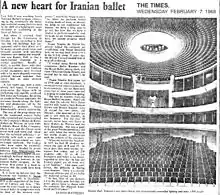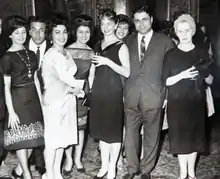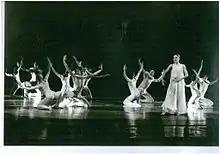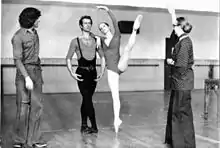| Iranian National Ballet Company سازمان باله ملی ایران | |
|---|---|
| General information | |
| Name | Iranian National Ballet Company سازمان باله ملی ایران |
| Successor | Les Ballets Persans Persian: سازمان باله ایران |
| Year founded | 1958 |
| Founder | Nejad Ahmadzadeh |
| Founding choreographers | William Dollar |
| Principal venue | Roudaki Hall Opera |
| Website | BalletsPersans.org |
| Senior staff | |
| Assistant Director | Haideh Ahmadzadeh |
| Artistic staff | |
| Artistic Director |
|
| Resident Choreographers |
|
| Other | |
| Sister company | National and Folk Music, Song and Dance Ensemble |
| Orchestra | Tehran Symphony Orchestra |
| Official school | National Ballet Academy of Iran |
| Formation |
|
The Iranian National Ballet Company (Persian: سازمان باله ملی ایران) was Iran's only state ballet institution until the Islamic revolution of 1979 and also the most known and recognized of all dance companies in the Middle East. It was founded in 1958 by the Iranian Ministry of Culture and existed during 21 years (1958–1979). The company, residing at Tehran's Roudaki Hall, was disbanded in the aftermath of the Islamic revolution and was re-established 23 years later in exile by Nima Kiann under the name of Les Ballets Persans (Persian: سازمان باله ایران) in Sweden.[1][2]
History
Introduction of ballet in Iran

The history of ballet in Iran started in 1928 when Madame Cornelli, a Russian immigrant who fled the Bolshevik revolution of 1917, started giving dance lessons in Tehran. There was no methodical ballet training; the classes consisted of various exercises to make the body supple and to cultivate the students' awareness of rhythm and musicality. Part of each class was devoted to character or folk dances.[3] A later dance teacher was Madame Yelena (Avedisian),[4] and Sarkis Djanbazian who respectively in 1933 and 1938 organized dance classes in the city of Tabriz and Qazvin. These newcomers expanded the European influenced dance scene in Iran by holding performances and dance classes of various style, including classical ballet, European folk dancing, the European partner dancing, etc.
Iran’s pioneering ballet company
In the early 1940s Nilla Cram Cook, who had vast knowledge in Eastern cultures and languages, was serving as the United States cultural attaché at the American Embassy in Tehran. During her time as the US culturаl attaché she became employed at the Ministry of Education and Propaganda, as director general of the Arts Department. Her endeavors and great interest in Persian culture, arts and literature resulted in the realization of the most extensive Iranian national dance project of the first half of the twentieth century. In 1946, Cram Cook founded the Studio of the Revival of the Iranian Ancient Arts (in Persian: استودیوی احیای هنرهای باستانی ایران), aiming to revive and restore the “forgotten” ancient Iranian performing arts. Most of the dances were based on Persian history or mythology. An important work by Cram Cook, The Caravan, was developed from a poem by Saadi and was later performed in 1958 by the Iranian National Ballet.[5] The dance troupe performed at functions at the American Embassy in Tehran and toured nationally and internationally, remaining active until around 1953.

Establishment of the national ballet company
In 1955, Mehrdad Pahlbod, the head of the Fine Arts department commissioned Nejad and Haideh Ahmadzadeh to start a ballet school on a professional basis aiming to raise native Iranian ballet dancers for a future national ballet company. The School was opened in 1956 in the premises of Tehran's Conservatory of Music. Two years later in 1958, the Iranian National Ballet Company was established with Nejad Ahmadzadeh as its founding director. When the Fine Arts Department of Iran eventually expanded and became The Ministry of Culture and Arts, Nejad Ahmadzadeh was appointed as director of the ballet academy, the ballet company and the National and Folk Music, Song and Dance Ensemble which was a sister company to the Iranian National Ballet Company using the same dancers to create and stage a nationally inspired repertoire.[6]


As institutionalizing ballet and bringing about a professional national ballet ensemble comparable to the ballet companies in the West had become a serious concern for the government, the Iranian monarch Mohammad Reza Shah Pahlavi had personally asked Dame Ninette de Valois to council on the formation of a ballet company during one of his official visits to London and after a command performance in his honor at the Royal Opera House. In the summer of 1958, Dame Ninette de Valois was visiting Turkey where she had founded a ballet school. On the invitation of the Ministry of Culture and Arts, she prolonged her trip in order to visit the National Ballet Academy of Iran and budding company in Tehran. On her return to London, she sent Ann Cox followed by Miro Michael Zolan and his wife Sandra Vane. Later Nicholas Beriozoff, Marion English-Delanian, Richard Brown and finally Robert and Jacqueline de Warren were sent by de Valois to teach and stage dances and short ballets for the ballet academy and company.
The Iranian National Ballet Company developed to become the most renowned Iranian cultural institution during its tenure as the country's only ballet institution. Company productions were often performed at official events and functions in the presence of the Royal family and invited national and international dignitaries.[7] The company moved to the Roudaki Hall Opera upon its completion in 1967.[8]
Repertoire

The company repertoire included classical, neoclassical and contemporary ballets which were staged usually by invited guest choreographers and ballet masters from Europe and the United States. The company established a close collaboration with dance institutions in Soviet Union, United States and Europe. The Royal Ballet, Royal Academy of Dance, Bolshoi Ballet, American Ballet Theatre were parts of a vast exchanging cultural program between the companies.
Some early works of the company were those choreographed by Nilla Cram Cook for the Revival of the Iranian Ancient Arts Ensemble which were restaged by Cram Cook's former dancers, Nejad and Haideh Ahmadzadeh.[7] Prominent and world-famous ballet dancers from renowned ballet companies of the world were often invited to dance the principal roles of all great classical ballets. In order to keep the high standard of the productions the company relied on guest artists from abroad to perform the leading roles in most work premieres.[8]
List of Iranian National Ballet Company productions
| Year / Season | Work | Composer | Chore / Staged by | Principal dancers |
|---|---|---|---|---|
| 1958 | The Caravan | Unknown | Nilla Cram Cook / Haideh Ahmadzadeh | |
| 1961 | The Classical Première | Gluck | Miro Zolan | |
| 1961 | 1+2=4 | Ravel | Miro Zolan | Avak Abrahamian |
| 1961 | Don Quixote Pas de deux | Minkus | Miro Zolan | Haideh Ahmadzadeh & Miro Zolan |
| 1961 | Rossiniada | Rossini | Miro Zolan | |
| 1961 | Fiesta | Kabalevsky | Sandra Vane / Miro Zolan | |
| 1962 | Libestraum | Strauss | Miro Zolan | |
| 1962 | The Entertainers | Miro Zolan | ||
| 1963 | The Nutcracker Pas de deux | Tchaikovsky | Marius Petipa / Miro Zolan | Haideh Ahmadzadeh & Leon Neshanian |
| 1963 | Comedie a la Francaise | Ibert | Richard Brown | |
| 1963 | Slaughter on Tenth Avenue | Rogers | George Balanchine / Richard Brown | Clara Avanessian |
| 1964 | La Péri | Paul Dukas | Ivan Clustine / Robert de Warren | Haideh Ahmadzadeh & Leon Neshanian |
| 1965 | Love and the Clown | Verdi | John Cranko / Robert de Warren | Haideh Ahmadzadeh, Avak Abrahamian, Jamshid Saghabashi |
| 1966 | Games | Ahmad Pejman | Robert de Warren | |
| 1966 | La Valse | Ravel | Robert de Warren | |
| 1966 | Symphony in C | Bizet | Robert de Warren | |
| 1966 | Tchaikovsky Suite | Tchaikovsky | Robert de Warren | |
| 1967 | Lady of the Camellias | / Robert de Warren | ||
| 1967 | The Firebird | Stravinsky | Michel Fokine / Robert de Warren | |
| 1968 | Phaedra | Auric | / Robert de Warren | Haideh Ahmadzadeh & Robert de Warren |
| 1968-69 | Romeo and Juliet | Prokofiev | John Cranko / Robert de Warren | Sarvar Kaboli & Amin Taati |
| 1968-69 | Cinderella | Prokofiev | / Robert de Warren | Sarvar Kaboli & Amin Taati |
| 1969-70 | The Sleeping Beauty | Tchaikovsky | Marius Petipa / Robert de Warren | Lucette Aldous & Robert Bestonso [lower-alpha 1] |
| 1970-71 | Giselle | Adolphe Adam | Jean Coralli & Jules Perrot / Anne Heaton | Adele Oroz & Viktor Rohna, [lower-alpha 2] Haideh Ahmadzadeh & Jamshid Saghabashi |
| 1971 - Autumn | The Myth of Creation [lower-alpha 3] | Melik Aslanian | Robert Thomas | |
| 1971-72 | Coppélia | Léo Delibes | Arthur Saint-Léon / Anne Heaton | Philippa Caire & Amin Taati, Haydeh Changizian & Jamshid Saghabashi |
| 1971-72 | Swan Lake | Tchaikovsky | Marius Petipa / Vakhtang Chabukiani | |
| 1971-72 | The Nutcracker | Tchaikovsky | Marius Petipa / Jack Carter | Carol Grant & Jamshid Saghabashi, Haydeh Changizian & Amin Taati |
| 1972-73 | Lieder eines fahrenden Gesellen | Gustav Mahler | Robert Thomas | Haydeh Changizian & Amin Taati / Marion English Delanian & Robert Thomas |
| 1972-73 | La Bayadère | Ludwig Minkus | Marius Petipa / Natalie Conus[lower-alpha 5] | Malika Sabirova & Mozaffar Burkhanov[lower-alpha 6] /Haydeh Changizian & Amin Taati, Haideh Ahmadzadeh in role of Gamzatti |
| 1972-73 | Unfinished Symphony (Pas de quatre) | Franz Schubert | Madjid Kashef | Haydeh Changizian & Riccardo Duse |
| 1973-74 | Fountain of Bakhchisarai | Boris Asafyev | Rostislav Zakharov / Natalie Conus | Raisa Strouchkova & Nikolai Fadeyechev ,[lower-alpha 7] Maggie Burton Saghabashi & Amin Taati, Haydeh Changizian, Avak Abrahamian |
| 1973-74 | La Fille Mal Gardée | Peter Ludwig Hertel | Dimitri Romanoff | Haydeh Changizian & Amin Taati, Haideh Ahmadzadeh as Widow Simone |
| 1973-74 | Boléro | Maurice Ravel | Madame Tilda from Romania | |
| 1973-74 | Petrushka | Igor Stravinsky | Michel Fokine / Madame Tilda from Romania | Jamshid Saghabashi |
| 1973-74 | Sinfonietta | Leoš Janáček | Miro Zolan | Haydeh Changizian |
| 1973-74 | Jigsaw | Boris Blacher | Miro Zolan | Haydeh Changizian |
| 1973-74 | The Scarecrow | Benjamin Britten | Miro Zolan | Marion English Delanian & Avak Abrahamian |
| 1973-74 | The Witch Boy | Leonard Salzedo | Jack Carter | Haydeh Changizian & Jamshid Saghabashi |
| 1975-76 | Les Sylphides | Frédéric Chopin | Michel Fokine / Anne Heaton | |
| 1975-76 | Schéhérazade | Rimsky-Korsakov | Michel Fokine / Anne Heaton (ballet dancer)|Anne Heaton | Haydeh Changizian as Zobeide,
Jamshid Saghabashi as the golden slave, Avak Abrahamian as Kalif |
| 1975-76 | Bijan and Manijeh[lower-alpha 8] | Hossein Dehlavi | Haideh Ahmadzadeh & Robert Urazgildiev | Haydeh Changizian & Jamshid Saghabashi |
| 1976-77 | Serenade | Tchaikovsky | George Balanchine / Patricia Neary | Janet Popeleski & Michael Dane |
| 1976-77 | Miss Julie | Rangström | Birgit Cullberg | Janet Popeleski & Chinko Rafique |
| 1976-77 | Graduation Ball | Johann Strauss II | / Nicholas Beriosoff | Maggie Burton Saghabashi & Chinko Rafique |
| 1976-77 | Swan Lake | Tchaikovsky | Marius Petipa & Lev Ivanov / Nicholas Beriosoff | Maggie Burton Saghabashi & Jamshid Sahabashi, Janet Popeleski |
| 1977-78 | Romeo and Juliet | Prokofiev | / Nicholas Beriosoff | Janet Popeleski & Robert Craset / Nina Brzorad and Jamshid Saghabashi |
| 1977-78 | The Nutcracker | Tchaikovsky | Marius Petipa / Nicholas Beriosoff | Janet Popeleski & Robert Craset / Nina Brzorad and Jamshid Saghabashi |
| 1977-78 | Carmina Burana | Carl Orff | John Butler | Janet Popeleski, Nina Brzorad, Robert Craset, Jamshid Saghabashi |
| 1977-78 | After Eden | Holby | John Butler | Janet Popeleski & Robert Crazet / Nina Brzorad and Jamshid Saghabashi |
| 1977-78 | Polovetsian Dances | Borodin | / Nicholas Beriosoff | |
| 1978-79 | Sleeping Beauty | Tchaikovsky | Marius Petipa / Nicholas Beriosoff | Nina Brzorad, Patricia Rensetti, Jamshid Saghabashi |
- ↑ from Royal Ballet
- ↑ from Budapest Opera Ballet followed by Irina Prokofyeva & Andrei Kondratoff from Bolshoi Ballet
- ↑ on the occasion of the 2,500 year celebration of the Persian Empire
- followed by Mette Höningen & Pale Jacobson from Royal Danish Ballet
- ↑ from Bolshoi Ballet in Moscow, even known as Natalia Konus
- ↑ soloists of Bolshoi Ballet from Tajik origin
- ↑ from Bolshoi Ballet
- ↑ The company’s first full-length classical ballet production based on Shahnameh of Ferdowsi
Artistic staff

The Iranian National Ballet Company started operating in 1958 with a dozen of dancers. The company grew to approximately 50 dancers, one third of them Iranian natives. The rest of the company members came mostly from Europe and the United States.[7][9][10][11]
Artistic directors
- Nejad Ahmadzadeh (1958–1976)
- Ali Pourfarrokh (1976–1979)
Principal choreographers
- William Dollar (1958–1960)
- Miro Zolan (1961–1963)
- Richard Brown (1963–1964)
- Jack Carter (1971)
- Anne Heaton (1973)
- Haideh Ahmadzadeh
- Robert Urazgildiev (1975)
- Birgit Cullberg (1975)
- Nicholas Beriosoff (1976–1979)
- John Butler
Ballet masters and mistresses
- William Dollar
- Miro Zolan
- Sandra Vane
- Yvonne Patterson (1959–1960)
- Marian English Delanian (1960 -1979)
- Robert de Warren (1965-1970)
- Jacqueline de Warren (1965–1970)
- Dudley Davies (1977–1979)
- Kenneth Mason (1976-1979)
Dancers
- Ayda Abolian
- Avak Abrahamian (Salmasi) (? - 1979)
- Valerik Abrahamian (? - 1979)
- Ahmad Adjdadi
- Adeleh Afrand
- Haideh Ahmadzadeh (1958–1975)
- Parvin Al-Amin
- Ronald K. Alexander
- Anne Allen (1978–1979)
- Jeremy Allen (1976 - 1979)
- Avisa Amirshahi
- Jenous Amirshahi
- Mary Apick
- Ahita Ardalan
- Azita Arfa
- Wendy Arshamian (? - 1979)
- Minoo Atabaki
- Clara Avanessian
- Ophelia Azarnia
- Banafsheh Bahramian
- Georgina Bahramian Coleman (? - 1979)
- Nejdeh Bahramian (? - 1979)
- James Bailey (1977–1978)
- Evelyn Balassanian (? - 1979)
- Mitra Behrouz
- Diana Biggart
- Nina Brzorad (1976–1979)
- Pippa Buck Power
- Aban Budin
- Margaret Bull
- Judyth Casey
- Haydeh Changizian (1972–1978)
- Tina Christina
- Robert Craset (1977–1979)
- Michael Dane
- Belinda (Lindy) Davies (? - 1979)
- Rosamund Davies
- Otis Daye (1977–1978)
- Rostam Dehmohbed
- Missy Denman (? - 1978)
- Yerjanik Djambazian
- Mehdi Doagoo
- Gavin Dorrian (1978–1979)
- Tomas Edwards (Martini) (? - 1978)
- Magdy El-Lethy (? - 1979)
- Jonathan Ellingham (1977–1979)
- Bahman Sadr Erfan
- Hilda Estepanian
- Fereshteh Fakoor
- Fereshteh Farazmand
- Ivan Ionathan Feller
- Martin Fredmann
- Parviz Ghanei (? - 1979)
- Farihan (Fari) Gheissari Akbarian
- Diane Gray (? - 1979)
- Michael Hall
- Mark Hammond (1977–1978)
- Mary Heathcote
- Caroline Heming (1977 - 1978)
- Dariush Hirbodian
- Behrooz Honarbakhsh
- Sarah Inglis Fricker (1970-1974)
- David Jackson (1976 - 1978)
- Nader Jahanfard
- Sarvar (Sorur) Kaboli
- Nina Kavosi
- Nasser Kazemi
- Sudabeh Keshmirian
- Sholeh Katherina Kia
- Shideh Kia Nikkhoo (? - 1979)
- Ladan Kianpoor
- Jeremy Macdonald (1977–1978)
- Osama Maksood (1978–1979)
- Robert March (1976–1977)
- Debbie McGee (1978–1979)
- Sam McManus
- Terri Mills Tester
- Frieda Minassian
- Golriz Mirjahangiri
- Nader Mirzadeh
- Rima Moghadam
- Farnoosh Moshiri
- Abdollah Nazemi
- Leon Neshanian
- Jaleh Nikpay
- Judith (Judy) Odell (1976 - 1978)
- Karen Oram
- Gita Ostovani
- Gregory Pope (1977–1978)
- Mary Paranicas (1977–1978)
- Janet Popeleski (1976 - 1978)
- Virginia (Ginny) Portz
- Tibor Pusztai - Conductor
- Mina Rad
- Chinko Rafique (? - 1977)
- Jaleh Rahbar
- Soheyla Razavi (? - 1979)
- Patricia Renzetti (1978–1979)
- Helen Riddington (1976 - 1978)
- Amanda Rivera Bruell (?-1978)
- Vivien Rycroft Richards (? - 1979)
- Soheila Sadr
- Jamshid Saghabashi (1958–1979)
- Fereydoon Saghabashi Tork
- Maggie (Burton) Saghabashi (? - 1979)
- Pari Samar
- Bahareh Sardari (? - 1979)
- John (Jay) Seaman (1977–1979)
- Susan Sepehran
- Roberta Senn Minto (1977–1978)
- Karen Smith (1977–1978)
- Azar Snider
- Sacha Spencer-Moore
- Diane Spinelli
- Clair Symonds Josephs
- Amin Taati
- Mersedeh Tahvildari
- Mary Tarverdian
- Kent Taylor (1978)
- Peggy Tehran
- Catherine Terzian
- Mark Thibodeau (1977–1978)
- Peter Towse (? - 1978)
- Behrooz Vasseghi (? - 1978)
- Samuel Veal (1976 - 1978)
- Ali Aschar Vil
- Bethan Wiliams (1977–1978)
- Trevor Wood
- Wendy Woodbridge (1977–1978)
- Jennifer (Jenny) Wyatt (1974–1979)
- Nazila Zand-Karimi
- Vazgen Zarokian
- Pejman Parhami (1975-1977)
Disbanding of the company

The civil unrest and political upheavals that caused the collapse of the Monarchy and establishment of a theocracy in Iran started in 1978 and was escalating rapidly. The last ballet production that was staged at the Roudaki Hall Opera was Sleeping Beauty during the fall season of 1978. By December 1978 and January 1979, the political situation of the country became more and more unstable. Almost all foreign members of the company left Iran during this period as soon as there was a flight available, before the complete collapse of the regime in February 1979. Employed dancers were informed that there were dismissed till the new government's further notice. Eventually, a meeting was arranged in Bāgh-e Manzariyeh in northern Tehran soon after the victorious revolution in the presence of Roudaki Hall's workforce and Ayatollah Mohammad Mofatteh. When he was asked about the fate of ballet in Iran, he replied irately and in no uncertain terms that Islamic Republic and ballet is paradoxical and self-contradictory. The Iranian National Ballet Company was thereafter formally declared as dissolved in 1979.[12]
Revival of the Iranian National Ballet Company in Les Ballets Persans
Twenty-three years after disbanding of the Iranian National Ballet, the Swedish-Iranian dancer, and choreographer Nima Kiann created a new company in Stockholm, Sweden[11] with the support of the Swedish authorities. Inspired by Les Ballets Russes and Ballets suédois as exiled dance companies representing vastly the culture of their countries, he named the company Les Ballets Persans (Persian: سازمان باله ایران).[13][14] The company repertory is entirely based on the Persian culture and heritage and does not include any works of the Western repertoire unless they are created based on Persian heritage. The project of revival of the Iranian National Ballet Company made an international impact and was regarded as the most extensive individual artistic project ever realized outside of Iran.
Notes
- On the 35th anniversary of disbanding of the company, on August 29, 2014, around forty former members of the Iranian National Ballet, including Nejad and Haideh Ahmadzadeh and Ali Pourfarrokh, gathered together in Washington DC to celebrate and share the accomplishments of the company. This was the first reunion of company members after leaving Tehran thirty-five years ago. In a message sent to this reunion, Nima Kiann the founder of Les Ballets Persans, the successor company of the Iranian National Ballet, wrote: ...On behalf of the new generation of Iranian ballet artists, I salute all attending and even absent members of the company this evening. Your collective accomplishment of the past time is today’s fundament on which this new generation is standing on. It is a reason of pride for the new and future generations of Iranians and a reminder of a passed time of development and progress for the art form of dance in Iran.[15]
See also
- Vahdat Hall
- Les Ballets Persans
- Official website of Nima Kiann
References
- ↑ Official website of Les Ballets Persans (The New Iranian National Ballet)
- ↑ Chronology of the Iranian National Ballet and Les Ballets Persans
- ↑ From book: My Life as a Persian Ballerina by Haideh Ahmadzadeh, p. 5
- ↑ Kiann, Nima (2000). Madame Yelena Avedisian. Eastern Dance Forum Archived 2014-12-03 at the Wayback Machine (Retrieved 2 Dec. 2014)
- ↑ From book: My Life as a Persian Ballerina by Haideh Ahmadzadeh; p. 21
- ↑ Ahmadzadeh, Haideh (2009). My life as a Persian Ballerina. Raleigh, NC: Lulu Enterprises Inc.
- 1 2 3 Kiann, Nima. "Persian Dance and Its Forgotten History". Eastern Dance Forum. Retrieved 2014-08-20.
- 1 2 Kiann, Nima (2015). History of Ballet in Iran. Wiesbaden: Reichert Publishing
- ↑ Community page of the Iranian National Ballets Company at Facebook. List of former members
- ↑ Community page of the Iranian National Ballets Company at Facebook. Timeline
- 1 2 Craine, Debra & Mackrell, Judith (2000). "Oxford Dictionary of Dance." New York: Oxford University Press
- ↑ Koegler, Horst (1987). The Concise Oxford Dictionary of Ballet. New York: Oxford University Press
- ↑ ’’Les Ballets Persans.’’ (2002). World Premiere souvenir program booklet. Stockholm: LBP Publications
- ↑ Patriot med mödosam mission. [Patriot with an arduous mission]. Article and interview in Göteborgs-Posten newspaper. 2000-01-26
- ↑ Nima Kiann’s message to the reunion. August 29, 2014
- Bibliography
- Craine, Debra (2009). The Ballets Russes and the Art of Design. New York: The Monacelli Press.